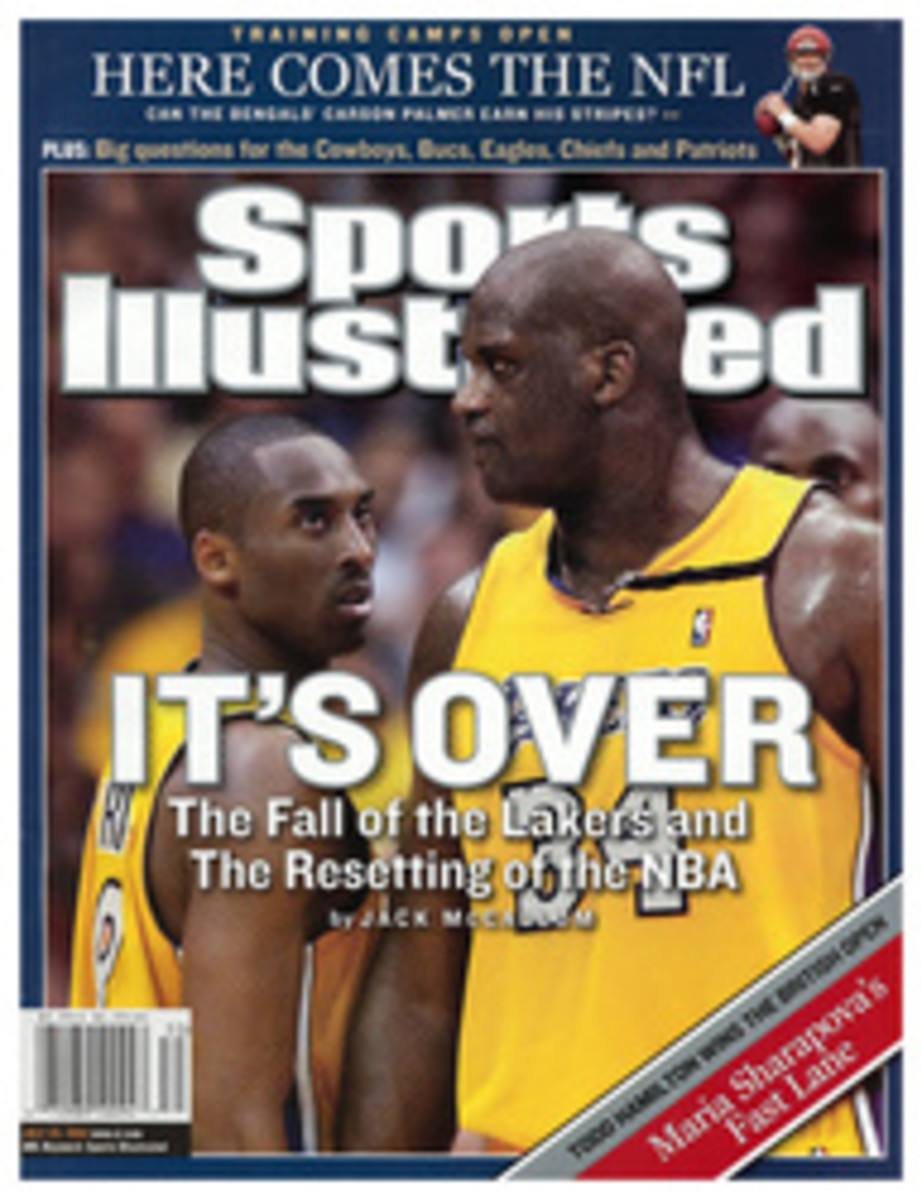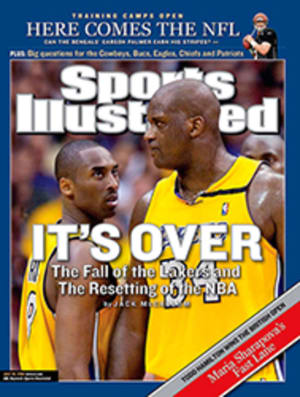
Uphill Battle Longer and steeper than the Tour de France's L'Alpe d'Huez (and don't forget the wind, the sleet and the fog), a race up Mount Washington takes exhausted cyclists above the clouds
"It is easier to go down a hill than up, but the view is from the
top."
--ARNOLD BENNETT, English novelist and playwright
The scene at the mountaintop observatory is surreal, like some
B-grade Hollywood horror flick. One by one, dozens of Lycra-clad
cyclists, shivering in fleece blankets, click-clack in their
cleated shoes across a concrete floor to escape an impenetrable
fog and biting, horizontal rains outside. They look gaunt and
delirious, with wicked smiles revealing one supremely satisfying
truth: They have conquered a brutal, unyielding stretch of
in-cline in northern New Hampshire called the Mount Washington
Auto Road.
"It's a wall," says Drew Miller, 36, of Flagstaff, Ariz., a
member of the Trek VW team. "Right from the gun, the road
disappears into the trees. You get going, and--Bam!--it's right
in your face, and it never really relents."
These days, it seems, it's the downhill bikers who get the
glory--adrenaline junkies adorned in body armor and bawdy tattoos
atop full suspension rigs that resemble motorcycles more than
bicycles. Their races are lightning-quick, made-for-television
bursts of power that hurtle them down hillsides at speeds
reaching 50 mph. But others know that the real badge of human
grit is earned in the climb. Judging from the number of
hill-climb events, such as the Everest Challenge in California
and Mount Evans in Colorado, these nasty tests of endurance,
character and sustained suffering are, well, the sport's
up-and-coming events.
The classic of the genre is the Mount Washington race, up a
6,300-foot granite knob. Even Miller, who has won Colorado's Iron
Horse Classic and finished second at the 14,200-foot Mount Evans
on three occasions, says he underestimated the ornery nature of
the Northeast's tallest peak. The Auto Road, first built in the
mid-1800s, features 72 turns and an average grade of 12%,
including an ungodly 22% stretch over the final 50 yards, while
rising almost 5,000 feet in 7.6 miles (steeper and longer than
the L'Alpe d'Huez of Tour de France infamy). Unlike at Mount
Evans, the New Hampshire race offers no run-up, no time to get
acclimated to the effort. From the start the paved road ascends
to the peak, eventually disintegrating to a patchy dirt and
gravel path scarred by rivulets formed by runoff. And every
August, 600 hardy cyclists come to take their measure of the
mountain.
"The only way to go is up, but the only way to go up is to put
yourself into this extra level of suffering," says two-time
winner Tim Johnson of Middleton, Mass. "You can't coast, you
can't relax, and you can't do anything but go super, super hard.
And maybe that is an attraction, because you learn new limits for
yourself."
It could be worse. According to a plaque outside the observatory,
the size of the Granite State's Presidential Range once rivaled
that of the Alps. Today, Mount Washington, at 6,288 feet, stands
as a testament to the corrosive power of the winds and rains that
swirl and occasionally rage through this unpredictable pocket of
the White Mountains. It was here, on April 12, 1934, that the
highest on-land wind speed--231 mph--was recorded. The first bike
climb was held in 1973. Once, in 1986, the race was called at the
halfway mark because of icy winds, and in 1993 and 1994 the race
was cancelled because of nasty weather, prompting organizers to
move the event from September to August in 1995.
Conditions can still be a challenge, however. "Although at last
year's race when the riders got to the five-mile mark and they
were hitting 50-to 60-mph winds, fog and drizzle, we thought
about calling the race," says race organizer Mary Power. "But we
didn't know that when they headed out."
That's Mount Washington. The weather often changes in a
heartbeat. Temperatures have been known to swing from the high
80s and sunshine at the base to subfreezing and hailstorms above
the treeline at 5,000 feet. "You have to be prepared for
anything," says Emily Thorne of Wenham, Mass., a former
professional cyclist who completed the climb in 1999 and hasn't
been back for an encore.
If the weather doesn't get you, a lack of willpower can. The
unyielding climb first attacks your legs, then your resolve.
After 30 minutes your mind can wander into dangerous places. And
you dare not submit to daydreaming, since the roadside has many
precipitous dropoffs and precious few guardrails.
Dale Stetina's 1980 record of 57 minutes, 41 seconds stood until
Tyler Hamilton of Marblehead, Mass., fresh off his debut ride in
the Tour de France, shattered the mark with a time of 51:56 in
1997. Two years later, under near-ideal conditions, Hamilton
soloed his way to a new mark of 50:21. "This is by far the
toughest climb I've done, and I've done a lot of tough climbs,"
said Hamilton (who on Saturday withdrew from that other bike race
over in France because of a back injury) after climbing off his
saddle in 1999.
For the next two years the race belonged to Johnson, who saw
Mount Washington as a symbolic obstacle, a hurdle he had to clear
during his transition from amateur racer to professional. "On the
pain scale, it's definitely up there, a 9.5 or 10," says the
Saunier Duval racer. "But the switch back to happiness is equally
as dramatic. Once you get to the top, in a second, everything is
O.K."
Johnson's reign atop Mount Washington came to an end in 2002,
when a tall, skinny kid with a scrappy streak ventured north.
Thomas Danielson, a Connecticut Yankee who spent two years honing
his two-wheeled chops at Fort Lewis College in Durango, Colo.,
took advantage of flawless conditions to shave almost a minute
off Hamilton's mark. "It's one of those climbs that's so
difficult it makes your head hurt," says Danielson. "I'd never
seen it before, and I think that helped." Last year, buffeted by
gale-force winds, Danielson won again, but almost a minute and a
half behind his 2002 mark.
"The second time, I remember thinking that I was just going to
float up that climb," he says. "Then you get started, and it's
like someone hitting you with a big hammer. Regardless of whether
you're having a good day or a bad day, it's painful."
Both Hamilton (5'8", 130 pounds) and Danielson (5'10", 135) have
the power-to-weight ratio that allows top-flight climbers to
seemingly soar up mountainsides. "That climb was made for Tom
Danielson," says his coach, Rick Crawford. "The steeper it goes,
the better his power-to-weight ratio gets. He's a wisp of a man.
You're talking about a very small car with a very large motor.
That's what makes guys like Tom and Tyler go uphill so well."
If Hamilton represents the perfect rider to attack Mount
Washington's grades, his father, Bill, represents the "everyman"
aspect of the race. "Tyler and his brother, Geoff, they race up
Mount Washington. I struggle up," says the elder Hamilton, 64. "I
don't do it fast, and I don't do it pretty, but I do get to the
top of the mountain."
Fewer than a quarter of the 600 riders have realistic hopes of
achieving the honor of a Top Notch time (1 hour, 20 minutes or
less), much less winning. Still, there's no shortage of
strivers--the race field filled within a month of the opening of
registration on Feb. 1, says Power. Since bicycles are permitted
on the road only twice a year (there's a two-hour "practice" ride
mid-July), there is a forbidden-fruit attraction. But for most,
it's simply the chance to tackle the road's near-vertical grades.
At this year's race, on Aug. 21, Danielson, Hamilton and Johnson
won't be there, due to other obligations. But the women's-record
holder, Genevieve Jeanson of Quebec, is expected. She first broke
the women's record in 1999 at age 17, winning an Audi before she
had her driver's license. Could she win overall honors this year?
Two years ago she set a new women's mark, at 54:02, finishing
third overall, and last year she was third again. "I'm small and
I'm thin," she says with a thick Quebecois accent, a smile and a
slight shrug.
And, clearly, willing to suffer.
TWO COLOR PHOTOS: PHOTOGRAPHS BY JONATHAN S. MCELVERY CLIMB TIME From the start (inset) the 600 upwardly mobile cyclists are confronted by a course that rises nearly 5,000 feet in 7.6 miles.
COLOR PHOTO: PHOTOGRAPHS BY JONATHAN S. MCELVERY MAKING THE GRADE There are no sprint finishes, as the final 50 yards of the race tilts to a thigh-busting 22% incline.
COLOR PHOTO: PHOTOGRAPHS BY JONATHAN S. MCELVERY SPOKESWOMAN Jeanson has twice taken third overall.
TWO COLOR PHOTOS: PHOTOGRAPHS BY JONATHAN S. MCELVERY FIFTY-MINUTE MAN In 2002 Danielson (inset) broke Hamilton's course record by nearly a minute in the first of his two straight wins.
"It's a wall," says one competitor. "Right from the gun, THE ROAD
DISAPPEARS INTO THE TREES. It never really
relents."
"Last year," Power says, "when the riders got to the five-mile
mark, they were HITTING 50-TO 60-MPH WINDS, FOG AND DRIZZLE."

